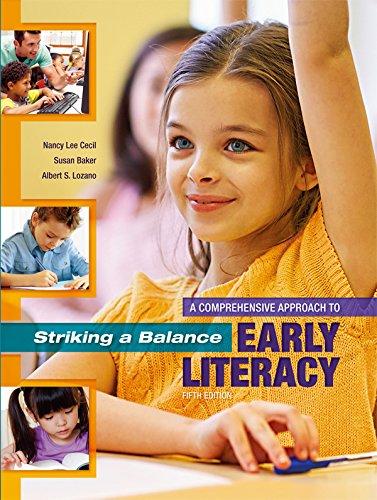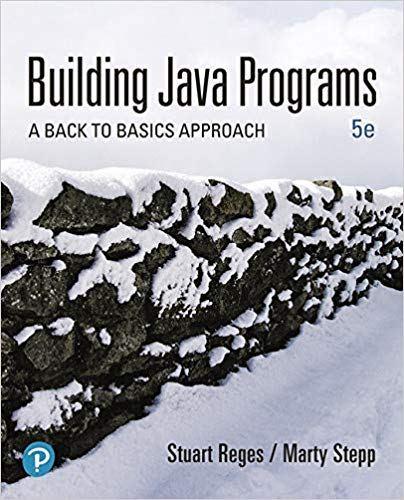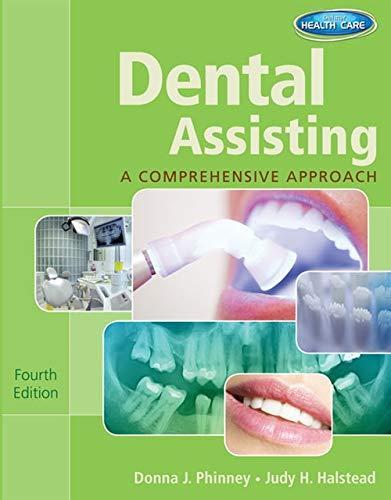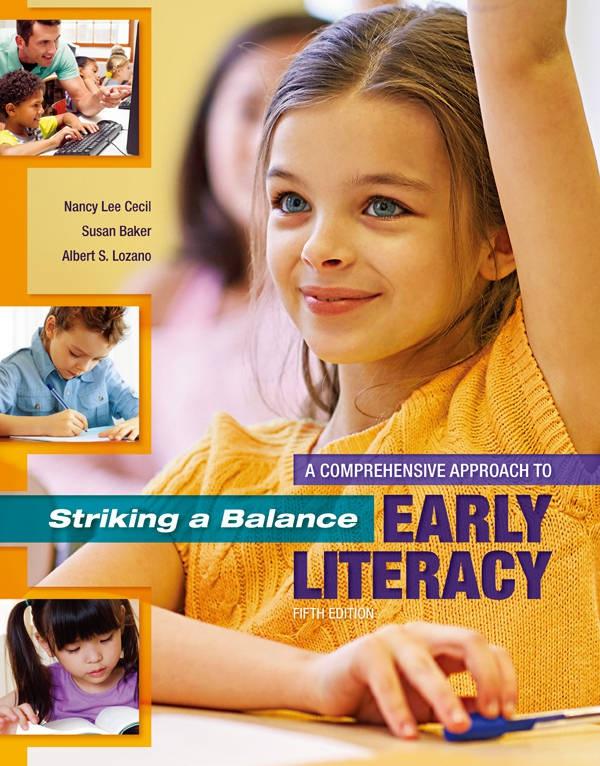https://ebookmass.com/product/striking-a-balancea-comprehensive-approach-to-early-literacy-5thedition-ebook-pdf/ Download more ebook from https://ebookmass.com

More products digital (pdf, epub, mobi) instant download maybe you interests ...

(eBook PDF) Labor Relations: Striking a Balance 6th Edition
https://ebookmass.com/product/ebook-pdf-labor-relations-strikinga-balance-6th-edition/

Dental Assisting: A Comprehensive Approach Donna J. Phinney
https://ebookmass.com/product/dental-assisting-a-comprehensiveapproach-donna-j-phinney/

Early Literacy in Preschool and Kindergarten: A Multicultural Perspective 4th Edition – Ebook PDF Version
https://ebookmass.com/product/early-literacy-in-preschool-andkindergarten-a-multicultural-perspective-4th-edition-ebook-pdfversion/

(eBook PDF) Building Java Programs: A Back to Basics Approach 5th Edition
https://ebookmass.com/product/ebook-pdf-building-java-programs-aback-to-basics-approach-5th-edition/

Dental Assisting:
A Comprehensive Approach 4th
Edition
https://ebookmass.com/product/dental-assisting-a-comprehensiveapproach-4th-edition/

Joint Structure and Function A Comprehensive Analysis 5th Edition, (Ebook PDF)
https://ebookmass.com/product/joint-structure-and-function-acomprehensive-analysis-5th-edition-ebook-pdf/

Selecting Effective Treatments: A Comprehensive, Systematic Guide to Treating Mental Disorders 5th Edition, (Ebook PDF)
https://ebookmass.com/product/selecting-effective-treatments-acomprehensive-systematic-guide-to-treating-mental-disorders-5thedition-ebook-pdf/

(eBook PDF) College Accounting (A Contemporary Approach) 5th Edition
https://ebookmass.com/product/ebook-pdf-college-accounting-acontemporary-approach-5th-edition/

Work-life Integration in Africa: A Multidimensional Approach to Achieving Balance 1st Edition Okechukwu E. Amah
https://ebookmass.com/product/work-life-integration-in-africa-amultidimensional-approach-to-achieving-balance-1st-editionokechukwu-e-amah/

Large-andSmall-GroupReadingStrategies
LiteracyandTechnologyinaBalancedClassroom EXPLORINGTODAY’SRESOURCES
AssessmentofEarlyLiteracyDevelopment INFORMINGINSTRUCTION
HomeasPartner THESHAREDCONNECTION
TheEarlyLiteracyClassroom ORCHESTRATINGACOMPREHENSIVEPROGRAM
Appendices
Glossary
References
AuthorIndex
SubjectIndex
1 2 Contents
ListofActivities
Preface
Acknowledgments
AbouttheAuthors
AChildLearnstoRead PROCESSANDPRODUCT intheclassroom
WhatIsReading?
TheoriesofReadingAcquisition
NonstageTheory▪StageTheory
CueingSystems
The Grapho-Phonological System ▪ The Syntactic (Sound Stream of Language) System ▪ The SemanticSystem▪ThePragmaticSystem
TheReadingProcess
Skills Used in the Reading Process ▪ Characteristics of the Reading Process ▪ The Reading ProcessandLearnersWhoAreDiverse
TheReadingProduct
Summary
questionsFORJOURNALWRITINGANDDISCUSSION suggestionsFORPROJECTSANDFIELDACTIVITIES
AQuestforBalance MOVINGFORWARD intheclassroom
Introduction
TheHistoryofEarlyLiteracy
Skills-Basedvs.HolisticApproach▪Standards-BasedEducation ApproachestoTeachingReading
Phonics Instruction and the Transmission Model ▪ Holistic Instruction and the Transactional Model▪AQuestforBalance:AComprehensiveApproach▪BalanceandTeachingtoStandards
TheImpactofTechnologyonLiteracy Summary
4
questionsFORJOURNALWRITINGANDDISCUSSION suggestionsFORPROJECTSANDFIELDACTIVITIES
EmergentLiteracy
FROMBIRTHTOCONVENTIONALLITERACY
intheclassroom
Introduction
LanguageAcquisition:AnOverview
Prebirth ▪ Infancy ▪ The Holographic Stage ▪ The Telegraphic Stage ▪ Preschool to Fluency ▪
PrimaryGrades
Literacy’sBeginnings
Reading Is Enjoyable ▪ Books Should Be Handled in Special Ways ▪ Book and Story Sharing InvolveaRoutine▪IllustrationsRepresentRealThings▪PrintedWordsHaveMeaning
ReadingReadiness:ARetrospective
OverviewofEmergentLiteracy
UseoftheTermEmergentLiteracy▪KeyComponentsofEmergentLiteracy
InfluencesonChildren’sLiteracyDevelopment
ContinuingLiteracyDevelopment
BOX:Videoscontaininginformationfordevelopingemergentliteracy
Understanding of Literacy Concepts ▪ Developing Cognitive Skills ▪ The Role of Early ChildhoodEducators,Parents,andCaregivers
GuidelinesforSettingUpaBalanced,ComprehensiveLiteracyProgramfromBirthtoPrimaryYears PositivePracticestoFosterEmergentLiteracy
BOX:TheCCSSandpre-Kliteracyeducation
Developing Concepts About Print ▪ Providing Direct and Vicarious Experiences ▪ Interactive StoryWriting▪ReadingAloudtoStudents:TheImportanceofPrintandBooks
BOX:Selectingabigbooktoreadaloud
BOX:Classicread-aloudsforyoungchildren
UsingDrama
EmergentLiteracyandChildrenwithSpecialNeeds
StrategiesforEnglishLearners
Summary
questionsFORJOURNALWRITINGANDDISCUSSION suggestionsFORPROJECTSANDFIELDACTIVITIES
PhonemicAwareness THESOUNDSOFOURLANGUAGE
intheclassroom
Introduction
TheImportanceofPhonemicAwareness
TheComponentsofPhonemicAwareness
BOX:Thehierarchyofphonemicawarenesscompetence
DevelopingPhonemicAwareness
GeneralGuidelines▪FromResearchtoPractice
PhonemicAwarenessandEnglishLearners
BOX:Helpingnon–Englishspeakers
PhonemicAwarenessandStudentswithSpecialNeeds
PhonemicAwarenessActivities
RecommendationsforTeachingPhonemicAwareness
Summary
questionsFORJOURNALWRITINGANDDISCUSSION suggestionsFORPROJECTSANDFIELDACTIVITIES
Phonics,SightVocabularyandFluency
intheclassroom
Introduction
WhyPhonicsInstruction?
BeginningPhonicsInstruction
ApproachestoSoundingOutWords
ASequenceforTeachingPhonics
TeachingSightVocabularyWords
AModelPhonicsProgram
Phonemic Awareness ▪ Useful Phonics Generalizations ▪ Whole-Part-Whole Instructional
Sequence ▪ Coaching ▪ Minilessons ▪ Application of Phonics Skills ▪ Use of Different Types of Literature▪TeachableMoments
GeneralSuggestionsforPhonicsInstruction
CASEEXAMPLE:Mrs Rodgersteachesaphonicslesson
ReadingFluency:MakingDecodingAutomaticThroughOralReading
Why Is Fluency Important? ▪ A Brief History of Fluency Instruction ▪ What Can Be Done to ImproveFluency?▪InteractiveReadingwithE-Books
StrategiesforEnglishLearners
ConsiderationsforStudentswithSpecialNeeds
Scope and Sequence Instruction ▪ Direct Instruction ▪ Multisensory Teaching ▪ Technology, Phonics,andSpecialNeeds
Summary questionsFORJOURNALWRITINGANDDISCUSSION suggestionsFORPROJECTSANDFIELDACTIVITIES
Spelling
AWRITER’STOOL
intheclassroom
LearningandApplyingSpellingSkills
TheStagesofSpellingDevelopment
Gentry’sStages▪Bear,Invernizzi,Templeton,andJohnston’sStages
ObservingExperimentalSpelling
CASEEXAMPLE:Tommy’sperspectiveonexperimentalspelling UnderstandingOurAlphabeticSystem
SupportingSpellingDevelopment
EarlyPhonetic/EarlyLetter-NameStage
BOX:Ideasformeaningfulspellinglists
Phonetic/LateLetter-NameandWithin-WordStage▪Transitional/SyllablesandAffixesSpelling
Stage▪APossibleWeek’sStudyPlan
ContractSpelling
StrategiesforEnglishLearners
ConsiderationsforStudentswithSpecialNeeds
ReflectingonSpelling▪WordListsandHigh-FrequencyWords▪PortableKeyboards
PracticestoAvoid
Summary questionsFORJOURNALWRITINGANDDISCUSSION suggestionsFORPROJECTSANDFIELDACTIVITIES
AcquiringWordMeanings
THEBUILDINGBLOCKSOFLITERACY
intheclassroom
Introduction
WhyAcquiringaMeaningVocabularyIsImportant PrinciplesofEffectiveVocabularyDevelopment
BOX:Teacherbehaviorsthatenhancevocabularylearning
Motivating Students to Read Independently ▪ Listening to the Teacher Read ▪ Other Factors in VocabularyDevelopment
TypesofVocabularyInstruction
Explicit Instruction in Meaning Vocabulary ▪ Strategies to Enhance Independent Meaning VocabularyGrowth
BOX:Vocabularydevelopmentinthecontentareas
StrategiesforEnglishLearners
Activate the Schema of the Learners ▪ Focus on Understanding ▪ Scaffold Vocabulary Usage ▪ UseMultisensoryandMultimediaApproaches▪ProvideOpportunitiestoShareHomeLanguage
▪FocusontheFunctionalUseofLanguage
VocabularyDevelopmentforStudentswithSpecialNeeds
ModifyingTraditionalApproaches
Summary
questionsFORJOURNALWRITINGANDDISCUSSION suggestionsFORPROJECTSANDFIELDACTIVITIES
ReadingComprehension
MAKINGSENSEOFPRINT
intheclassroom
WhatIsComprehension?
AnIdealClimateforCriticalThinking
Knowledge▪ThinkTime▪Praise
ReadingStrategiesforComprehending
EssentialStrategiestoTeach▪TeachingtheUseofComprehensionStrategies
CASEEXAMPLE:JaneWaskeiwitzteachesvisualizing
InstructionalActivitiesforTeachingComprehension
ComponentsofaSuccessfulComprehensionProgram
Devote a Large Block of Time for Actual Text Reading ▪ Engage in Close Reading of Text ▪
Provide Opportunities for Reading in a Social Setting ▪ Give Students Access to Plenty of Children’s Literature ▪ Provide Opportunities for Personal Response to Text ▪ Consider the LanguageandCultureofAllLearners
BOX:Selectingmulticulturalchildren’sliterature
ImprovingComprehensionforEnglishLearners
ReadingComprehensionandStudentswithSpecialNeeds
Summary questionsFORJOURNALWRITINGANDDISCUSSION suggestionsFORPROJECTSANDFIELDACTIVITIES
Writing-ReadingConnections
RECIPROCALPATHSTOLITERACY
intheclassroom
Introduction
WritingGoalsforEarlyReaders
WritingWorkshop
OpenFormatWorkshop▪GenreStudyWorkshop
TheWritingProcess
Prewriting (Exploring the Topic) ▪ Drafting (Getting Ideas Down) ▪ Sharing (Pre-revising, Getting Feedback) ▪ Revising ▪ Editing (Making Corrections) ▪ Publishing (Polishing for Presentation)
WritingStructures
Story Frames ▪ Literacy Scaffolds ▪ Prompts for Opinion Pieces ▪ Journal Writing ▪ Class
Newspaper
TheLanguageExperienceApproach
StepsintheLEA▪VariationsontheBasicLEA
OnlineExperiencesforLiteracyandLearning
WritingandStudentsWhoAreEnglishLearners
WritingforStudentswithSpecialNeeds
Summary
questionsFORJOURNALWRITINGANDDISCUSSION suggestionsFORPROJECTSANDFIELDACTIVITIES
InformationalTextintheClassroom READINGANDWRITINGTOLEARN
intheclassroom
WhyInformationalTextIsImportant
WhyInformationalTextIsChallenging
PrinciplesofUsingInformationalText
Use Text Features for Previewing ▪ Establish an Authentic Context and Purpose for Reading ▪
UseinConjunctionwithOtherFormsofText
TeachingYoungStudentstoReadInformationalText
Teacher Think-Alouds ▪ Explicit Instruction of Organizational Patterns ▪ Minilessons ▪ Other
InstructionalStrategiesforInformationalText
WritingInformationalText
StructuringInformationalWriting▪InstructionalStrategiesforWritingInformationalText
StrategiesforEnglishLearnersandReadingandWritingInformationalText
InformationalTextandStudentswithSpecialNeeds
Summary
questionsFORJOURNALWRITINGANDDISCUSSION suggestionsFORPROJECTSANDFIELDACTIVITIES
Large-andSmall-GroupReadingStrategies CREATINGALITERATECOMMUNITY
intheclassroom
Introduction
SharedReading
PurposesforSharedReading▪ProceduresforSharedReading
CASEEXAMPLE:AsharedreadingexperienceinMr Jimenez’sclassroom
GuidedReading
Purposes for Guided Reading ▪ The Role of Questioning in Guided Reading ▪ Leveled Texts ▪
ProceduresforGuidedReading
GroupingforInstruction
12
LeveledGroups▪SkillGroups▪LiteratureCircles
BOX:Moreaboutliteraturecircles
Pairs(BuddyReading)▪Peer-EditingGroups▪CooperativeGroups
OtherPracticesforGroupReading
Masking
Music
BOX:Linkingliteracyandlyrics
MultimediaPackages▪PocketCharts▪WordWalls▪ClozeActivities
Small-GroupReadingandEnglishLearners
Large-andSmall-GroupReadingandStudentswithSpecialNeeds
MakingTextAccessibleforAllLearners
SelectivePairing▪OnlineBooks▪EchoReading▪BuildingBackground▪DelayingIndependent
Reading▪EncouragingaVarietyofResponses
Summary
questionsFORJOURNALWRITINGANDDISCUSSION suggestionsFORPROJECTSANDFIELDACTIVITIES
LiteracyandTechnologyinaBalancedClassroom EXPLORINGTODAY’SRESOURCES
intheclassroom
Introduction
VisualLiteracy
Viewing▪VisuallyRepresenting
TechnologyApplicationsforLiteracyLearning
WritingElectronically
CASEEXAMPLE:Ms Pfeifer’sclasswriteselectronically
Creating Multimodal/Hypermedia Projects▪Online Reading and Researching ▪ Communicating andCollaboratinginOnlineCommunities▪InteractiveReading:E-Books
BOX:Readingandwritingworkshopsandtechnology
ChoosingTechnologyApplications
TechnologyandEnglishLearners
TechnologyandStudentswithSpecialNeeds
TeacherProfessionalDevelopment
Summary questionsFORJOURNALWRITINGANDDISCUSSION suggestionsFORPROJECTSANDFIELDACTIVITIES
13
AssessmentofEarlyLiteracyDevelopment INFORMINGINSTRUCTION
intheclassroom
Introduction
WhyAssess?
PrinciplesofAssessment
TheCoreofAssessmentIsDailyObservation▪StudentsAreActivelyEngagedintheAssessment Process▪AssessmentTakesManyDifferentForms▪AssessmentAvoidsCulturalBias
TypesofAssessment
Skills-BasedAssessment▪Curriculum-BasedAssessment▪Process-OrientedAssessment
FormalAssessmentProcedures
BOX:Anassessmentprogram
AchievementTests▪Criterion-ReferencedTests▪DiagnosticReadingTests
InformalAssessmentProcedures
InformalReadingInventory▪RunningRecord▪AnecdotalNotes▪SightWords
BOX:Observablebehaviorsforanecdotalnotes
ClozeTests▪InterestandAttitudeInventories▪StoryRetelling
AssessingSpecificComponentsofLiteracy
AssessingPhonemicAwareness▪AssessingPhonicsSkills
BOX:Assessingphonemicawareness
AssessingFluency
BOX:Phonicsassessmentinventory
AssessingVocabularyandWriting
ResponsetoIntervention:BlendingAssessmentandIntervention
CompilingandSummarizingAssessmentInformation
CASEEXAMPLE:RTIinaction:LiteracysuccessforLandon Portfolios▪GroupProfiles
UsingAssessmenttoInformInstruction
CASEEXAMPLE:Fromdiagnosistointerventiontoavidreader:Chelsea’sjourney
Summary
questionsFORJOURNALWRITINGANDDISCUSSION suggestionsFORPROJECTSANDFIELDACTIVITIES
HomeasPartner
THESHAREDCONNECTION
intheclassroom
Introduction
ResearchonHomeLiteracy
UnderstandingDifferencesinHomePractices
HelpingParentsWhoCannotRead
CommunicatingwithParents
Conferences
BOX:Guidelinesforeffectiveparent–teacherconferences
ParentWorkshops▪OtherCommunicationwithParents
ReadingAloudToandWithChildren
OtherSuggestionsforParents
FamilyLiteracyPrograms
BOX:Readingaloudtoinfantsandtoddlers
Troubleshooting
FlexibleScheduling▪HomeVisits▪CommonLanguage
Summary
questionsFORJOURNALWRITINGANDDISCUSSION
suggestionsFORPROJECTSANDFIELDACTIVITIES
TheEarlyLiteracyClassroom ORCHESTRATINGACOMPREHENSIVEPROGRAM
intheclassroom
Introduction
AClassroomClimateConducivetoLiteracy
Print Saturation ▪ Demonstrations ▪ High Expectations ▪ Teacher Feedback ▪ Instructional
ModificationsandDifferentiation
OrganizingtheClassroomEnvironment
RoomArrangement▪LiteracyMaterials
DevisinganInstructionalPlan
CASEEXAMPLE:AdayinMrs Ramon’sclassroom
Summary
questionsFORJOURNALWRITINGANDDISCUSSION suggestionsFORPROJECTSANDFIELDACTIVITIES
APPENDICES
Children’sLiteratureResources
RecommendedBooksforTeachers
WebsitesforEarlyLiteracy
CommercialAssessmentInstruments
InformalChecklistsandAssessmentDevices
RimesandCommonWordsContainingThem
Fry’sListof“InstantWords”
PhonicsTermsandOrthographyChart
Glossary
References
AuthorIndex
SubjectIndex
5 6 7
ListofActivities
PhonemicAwareness
Rhyming
WordBeginnings(Onsets)
ComparingandContrastingSounds
BlendingSounds
SubstitutingSounds
SegmentingSounds
ManipulatingPhonemes
Phonics,SightVocabularyandFluency
AlsoseetheCaseExample“Mrs Rodgersteachesaphonicslesson”(pp 92–95)forphonicsactivities
SoundSwitch
RollCallVariation
ActivitiesforIncreasingFluency
WordBuilding
Spelling
Alsoseethesection“supportingspellingdevelopment”(pp 117–122)forspellingactivities
SpellinginParts(SIP)
Think,Pair,Share
AcquiringWordMeanings
AWordMap
ASemanticMap
Context-RelationshipProcedure
SemanticGradient
PossibleSentences
UsingtheContextThink-Aloud
ContextualRedefinition
DivideandConquer
WordHunts
ClassDictionary
LearningNewWords
Reader-SelectedVocabularyProcedures(RSVP)
WordAerobics
ReadingComprehension
DirectedListening–ThinkingActivityandDirectedReading–ThinkingActivity StructuredListeningActivity(SLA)
DyadReading
StoryPrediction
Think-Aloud
Think-AloudMysteries
ReciprocalTeaching
TheKnowledgeChart
Experience–TextRelationship
Question–AnswerRelationships
Writing-ReadingConnections
Alsoseethesection“writingstructures”(pp 191–198)forwritingactivities
ASimpleLiteracyScaffold
ImagineWhatHappens!
InformationalTextintheClassroom ExpectationGrid
MakingPredictionsfromArtifacts RetellingInformationalTexts UsingExpositoryFrames WritingPersuasivePieces PartnerReadingandContent,Too(PRC2)
LiteracyandTechnologyinaBalancedClassroom CreatingaVideo
DigitalStorytelling
WebsiteExploration
WebQuest
HomeasPartner
Questioning
ParentThink-Aloud
DyadReading
Another random document with no related content on Scribd:
NOTE:
1. CARDUCCI, Opere. Bologna, Zanichelli, vol. IV, pag. 3 e seg.
2. CARDUCCI, Opere. Bologna, Zanichelli, vol. III, pag. 143 e seg.
3. BORGOGNONI, Biografia del Carducci premessa alla terza edizione delle Poesie di lui. Firenze, Barbèra, 1878, pag. X.
4. BORGOGNONI, op. cit., pag. XIV.
5. Il Padre Pistelli le raccolse veramente per uso di Guido Biagi; il quale volle gentilmente comunicarmele; di che gli son grato.
6. Consule Planco, Lettera a Ferdinando Martini, pubblicata nella Domenica letteraria del 30 aprile 1882, come saggio del volume Il primo passo stampato a cura di quel giornale.
7. BORGOGNONI, op. cit., pag. XVII.
8. CARDUCCI, Opere, vol. IV, pag. 7 e seg.
9. BORGOGNONI, op. cit., pag. XVIII.
10. Era il soprannome stato messo al Carducci alla Scuola Normale, «causa, dice egli stesso, un raddoppiamento spostato nella coniugazione del verbo πίνειν.» Vedi CARDUCCI, Opere, vol. IV, pag. 19.
11. FERDINANDO CRISTIANI, Il Carducci alla Scuola Normale, nella Rivista d’Italia, anno IV, fasc. V (maggio 1901), pag. 44 e seg.
12. CRISTIANI, Scritto citato, opera citata, pag. 46.
13. CRISTIANI, Scritto cit., op. cit., pag. 48 e 49.
14. CRISTIANI, Scritto cit., op. cit., pag. 49.
15. Vedi lo scritto di GUIDO MAZZONI, Giosue Carducci e Gaspero Barbèra, nel citato fascicolo della Rivista d’Italia, pag. 59.
16. Questi tre sonetti sono ristampati nel libro V dei Juvenilia sotto i n. LXXIII, LXXIV, LXXV, con poche modificazioni il 1º e il 3º, mutato assai, e scorciato d’un terzo nella coda, il 2º. Anche l’ordine loro è cambiato: viene primo quello Ai poeti odiernissimi, col semplice titolo Ancora ai poeti; secondo quello Ai filologi, col titolo A scusa d’un francesismo scappato nelprecedente sonetto; terzo quello Alla musa odiernissima, il cui titolo è rimasto immutato.
17. CARDUCCI, Opere, vol. V, pag. IV.
18. CARDUCCI, Opere, vol. IV. pag. 19.
19. Ivi, pag. 20.
20. CARDUCCI, Opere, vol. IV, pag. 20, 21.
21. CARDUCCI, Opere, vol. cit., pag. 21, 22.
22. CARDUCCI, Opere, vol. cit., pag. 35.
23. CARDUCCI, Opere, vol. IV, pag. 36, 37.
24. CARDUCCI, Opere, vol. IV, pag. 52, 53
25. Vedi Opere, vol. IV, pag. 29 e seg.
26. Vedi la lettera a pag. 51 e seg. del citato fascicolo della Rivista. L’autore anonimo degli articoli del Passatempo era, come poi sapemmo, e come il Del Lungo scrive nella sua lettera a me, Corrado Gargiolli, che in seguito cercò con grande insistenza l’amicizia di lui. Vedi nelle note a questo capitolo l’articolo del Carducci sulla poesia del Del Lungo.
27. Vedi CARDUCCI, Opere, vol. IV, pag. 76 e seg.
28. CHIARINI, Giosue Carducci, Impressioni e ricordi. Bologna, Zanichelli, 1901, pag. 303.
29. Vedi CARDUCCI, Opere, vol. IV, pag. 72 e seg.
30. Rivista d’Italia, fascicolo del maggio 1901, pag. 62.
31. CARDUCCI, Opere, vol. IV, pag. 44.
32. Rivista d’Italia, loc. cit.
33. CARDUCCI, Opere, vol. II, pag. 441 a 484.
34. Poesie diGiosue Carducci. Bologna, Zanichelli, 1901, pag. 370.
35. Chi fosse curioso di maggiori particolari sulle case abitate dal Carducci a Bologna, li troverà nell’articolo di Ugo Pesci, Il Carducci intimo, nella Rivista popolare illustrata, Ilsecolo XX(n. VI, novembre 1902).
36. Nelle edizioni definitive delle Poesie fu messo nei Juvenilia.
37. Era la Rivista italiana di scienze, lettere ed arti, con le effemeridi della pubblica istruzione, che si pubblicava a fascicoli settimanali di 16 pagine in Torino, e della quale parlerò più avanti.
38. Doveva essere, e fu, pubblicato nel volume Dante e il suo secolo, messo insieme da Gaetano Ghivizzani e stampato dal Cellini in occasione del centenario dantesco.
39. Nel n. 33, anno III, del Giornale d’Italia (2 febbraio 1903).
40. Era la graziosa edizione di Virgilio, col comento latino ad imitazione di quelli del Bond, pubblicata da qualche anno, poco dopo quella dell’Orazio.
41. Si allude ad Alfonso La Marmora, allora Presidente del Consiglio.
42. Vedi due lettere del Carducci a Gaspero Barbèra nelle Memorie di un Editore, pagg. 569 e 572.
43. Vedi la difesa mandata dal Carducci al Consiglio Superiore, nel vol. V delle Opere a pag. 56 e seg., la quale fu contemporaneamente stampata nel giornale L’Amico del Popolo di Bologna del 7 aprile 1868. Vedi anche la prefazione ai Giambi ed Epodi nel vol. IV delle Opere.
44. GIUSEPPE ALBINI, Il Carducci nella scuola, in Rivista d’Italia, fascicolo del maggio 1901, pag. 91
45. Dal giornale di Bologna La Vedetta, anno I, n. 2 (20 ottobre 1876).
46. CARDUCCI, Opere, vol. IV, pag. 464 e seg.
47. CARDUCCI, Opere, vol. IV, pag. 357.
48. CARDUCCI, Opere, vol. XII, png. 235, 238 e 239.
49. CARDUCCI, Opere, vol. cit., pag. 242.
50. Ivi, pag. 243.
51. MARIO MENGHINI, Il Carducci a Roma, nel fascicolo del maggio 1901 della Rivista d’Italia, pag. 126.
52. La Nuova Rassegna, anno I, n. 3 (5 febbraio 1893).
53. La Nuova Rassegna, num. cit.
54. La Nuova Rassegna, num. cit.
55. Maria Teresa Di Serego-Alighieri Gozzadini, con prefazione di GIOSUE CARDUCCI. Bologna, Zanichelli, 1884.
56. AVERARDO BORSI, Il Carducci in Maremma; nella Rivista d’Italia, fascicolo del maggio 1901, pag. 33, 34.
57. Giulio Gnaccarini, che fu poi sposo della Lauretta.
58. BORSI, scritto cit., pag. 36, 37.
59. Livorno, Tipografia Giusti, 1895.
60. Insieme con la romanza spagnuola, La lavandaia di San Giovanni, il Carducci pubblicò in quel primo numero della Rassegna settimanale la ballata danese Sir Òluf (La figlia del re degli elfi), raccogliendole tutte due sotto il titolo Da mezzogiorno a settentrione. La stessa Rassegna pubblicò poi, i primi cinque capitoli dell’Intermezzo nel n. 5 (3 febbraio 1878), la prima parte della Canzone di Legnano nel n. 65 (30 marzo 1879), e le due odi barbare Ave e Nevicata nei nn. 120 (18 aprile 1880) e 170 (3 aprile 1881).
61. CARDUCCI, Opere, vol. I, pag. 224, 225.
62. Il Libro delle prefazioni, stampato nel 1888 dall’editore Lapi di Città di Castello, fu fatto pubblicare, col consenso dell’autore, dagli scrittori del giornale Il Capitan Fracassa, che lo diedero in premio ai loro associati. Contiene, oltre la prefazione, i seguenti scritti: 1º Cino da Pistoia ed altri rimatori delsecolo XIV, 2º Lorenzo de’ Medici, 3º Alessandro Tassoni, 4º Vita di Salvator Rosa, 5º Della poesia melica italiana e di alcuni poeti erotici del secolo XVIII, 6º La lirica classica nella seconda metà del secolo XVIII.
63. Le Terze Odi barbare di Giosue Carducci: articolo di Angelo Tomaselli nella Rassegna emiliana, anno II, fasc. V.
64. MARIO MENGHINI, Il Carducci a Roma; in Rivista d’Italia fascicolo di maggio 1901, pag. 130, 131.
65. MENGHINI, scritto cit., pag. 133.
66. CARDUCCI, Opere, vol. XII, pag. 440.
67. Vedi CARDUCCI, Opere, vol. XII, pag. 568.
68. CARDUCCI, Opere, vol. XII, pag. 569.
69. CARDUCCI, Opere, vol. XII, pag. 570.
70. CARDUCCI, Opere, vol. XI, pag. 369.
71. CARDUCCI, Opere, vol. XII, pag. 572 e seg.
72. Vedi il giornale IlMarzocco, anno V, n. 19 (13 maggio 1900).
73. Ugo Pesci, generalmente bene informato delle cose riguardanti il Carducci, in un diligente e interessante articolo, Il Carducci intimo, pubblicato nel Secolo XX (n. VI, novembre 1902) scrive a proposito della morte del Bevilacqua: «Una mattina nella primavera del ’99 la morte lo colse all’improvviso, su la cattedra, mentre faceva lezione; ed i suoi due figli più grandi, ancora adolescenti, ascoltavano in una sala vicina la lezione d’un altro maestro!» Ciò non è esatto. Carlo Bevilacqua morì la mattina del 2 dicembre 1898 nel suo letto, per malattia quasi improvvisa (dissero una colica epatica) che gli si era manifestata con grande violenza due giorni innanzi. Nel giorno 30 novembre aveva fatto regolarmente le sue lezioni e preso parte attivissima ad una adunanza del Collegio degli insegnanti, senza accusare nessun disturbo. La notte gli prese il male; nel giorno di poi migliorò; la mattina seguente ebbe un improvviso peggioramento, e morì. Era nato a San Quirico di Moriano presso Lucca il 6 aprile 1849.
74. Vedi il libro di Giulio Padovani, A vespro. Bologna, Zanichelli, 1901, pag. 109.
75. CARDUCCI, Opere, vol. III, pag. 271.
76. CARDUCCI, Opere, vol. III, pag. 280.
77. Nuova Antologia, vol. XX (seconda serie), pag. 374.
78. CARDUCCI, Opere, vol. XII, pag. 161.
79. Polemica novissima, per LUIGI ALBERTI. In Firenze, pei tipi dell’Arte della Stampa, 1878.
80. GIOVANNI RIZZI, Un grido; quarta edizione con Appendice. Milano, Brigola, 1879.
81. CARDUCCI, Opere, vol. XI, pag. 295.
82. Quelli scritti polemici furono poi raccolti in un libretto, intitolato: Alla ricerca della verecondia. Roma, Sommaruga, 1884.
83. CARDUCCI, Opere, vol. III, pag. 436.
84. Ciò che è detto qui dei Saggi su l’Aminta serva di correzione e compimento a ciò che dei Saggi stessi è detto a pag. 317 di questo volume.
85. Il Carducci morì il 16 febbraio allo ore 1,28. Aveva avuto un attacco d’influenza l’8 febbraio, del quale il 12 pareva guarito, tanto che espresse il desiderio di alzarsi; ma il 14 tornò la febbre con bronchite e pneumonite, che tolsero subito ogni speranza di guarigione.
86. Data nella prima lettera, con la quale il Carducci parlava della malignità del suo critico.
87. Così sta questo verso nella prima edizione delle Rime (San Miniato, 1857); e così fu riprodotto in tutte le altre fino all’ultima delle Poesie complete in un volume. È singolare che l’autore non si accorgesse che la rima non è esatta, o che, se se ne accorse, credesse bene di non correggere.
88. Debbo le prime due di queste lettere alla cortesia del professore Adriano Augusto Michieli, che le copiò per me dalla Marciana di Venezia, ove conservansi con altre carte del Carducci. La terza fu stampata nel Giornale d’Italia 30 marzo 1907 a cura del signor G. Emilio Curàtulo. Le altre due le pubblicai io stesso nel fascicolo del maggio 1901 della Rivista d’Italia.
Nota del Trascrittore
Ortografia e punteggiatura originali sono state mantenute, correggendo senza annotazione minimi errori tipografici.
Copertina creata dal trascrittore e posta nel pubblico dominio.
*** END OF THE PROJECT GUTENBERG EBOOK MEMORIE DELLA VITA DI GIOSUE CARDUCCI (1835-1907) ***
Updated editions will replace the previous one—the old editions will be renamed.
Creating the works from print editions not protected by U.S. copyright law means that no one owns a United States copyright in these works, so the Foundation (and you!) can copy and distribute it in the United States without permission and without paying copyright royalties. Special rules, set forth in the General Terms of Use part of this license, apply to copying and distributing Project Gutenberg™ electronic works to protect the PROJECT GUTENBERG™ concept and trademark. Project Gutenberg is a registered trademark, and may not be used if you charge for an eBook, except by following the terms of the trademark license, including paying royalties for use of the Project Gutenberg trademark. If you do not charge anything for copies of this eBook, complying with the trademark license is very easy. You may use this eBook for nearly any purpose such as creation of derivative works, reports, performances and research. Project Gutenberg eBooks may be modified and printed and given away you may do practically ANYTHING in the United States with eBooks not protected by U.S. copyright law. Redistribution is subject to the trademark license, especially commercial redistribution.
START: FULL LICENSE
